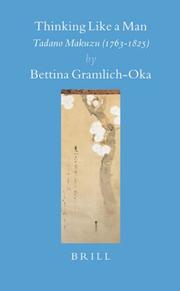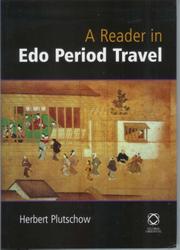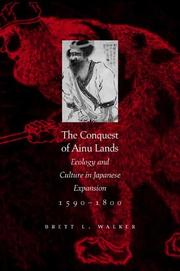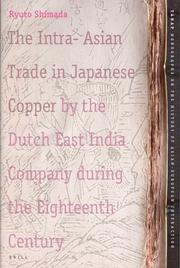| Listing 1 - 7 of 7 |
Sort by
|

ISBN: 1281399620 9786611399627 9047410009 9789047410003 9004152083 9789004152083 9781281399625 9004152083 9789004152083 6611399623 Year: 2006 Publisher: Leiden ; Boston : Brill,
Abstract | Keywords | Export | Availability | Bookmark
 Loading...
Loading...Choose an application
- Reference Manager
- EndNote
- RefWorks (Direct export to RefWorks)
This book, which deals with the life and ideas of the poet and philosopher Tadano Makuzu (1763-1825), presents insights into gender discourses of the late Tokugawa period (1600-1868), and thereby opens a way to break away from conventional intellectual history.
Tadano, Makuzu, --- Tadano, Ayako, --- Tadano, Makuzuko, --- Makuzu, Tadano, --- 只野真葛, --- J1560 --- J2284.60 --- J4000.60 --- J4165 --- Japan: Philosophy -- individual philosophers -- Kinsei, Edo, Tokugawa period, early modern (1600-1867) --- Japan: Genealogy and biography -- biographies -- Kinsei, Edo, Tokugawa period, early modern (1600-1867) --- Japan: Social history, history of civilization -- Kinsei, Edo, Tokugawa period, early modern (1600-1867) --- Japan: Sociology and anthropology -- communities, social classes and groups -- scholars, students, intellectuals
Book
ISBN: 9782251410340 2251410341 Year: 2006 Volume: 22 Publisher: Paris : Les Belles Lettres,
Abstract | Keywords | Export | Availability | Bookmark
 Loading...
Loading...Choose an application
- Reference Manager
- EndNote
- RefWorks (Direct export to RefWorks)
Japan --- Japon --- History --- Civilization --- Civilisation --- J3360 --- J4000.60 --- Japan: History -- Kinsei, Edo, Tokugawa period, early modern (1600-1867) --- Japan: Social history, history of civilization -- Kinsei, Edo, Tokugawa period, early modern (1600-1867) --- Nihon --- Nippon --- Iapōnia --- Zhāpān --- I︠A︡ponii︠a︡ --- Yapan --- Japão --- Japam --- Mư̄ang Yīpun --- Prathēt Yīpun --- Yīpun --- Jih-pen --- Riben --- Government of Japan --- 日本 --- 日本国 --- Nipponkoku --- Nippon-koku --- Nihonkoku --- Nihon-koku --- State of Japan --- Япония --- Japani --- اليابان --- al-Yābān --- يابان --- Yābān --- Japonsko --- Giappone --- Japonia --- Japonya --- Histoire --- Japanese history --- 17th-19th centuries --- Jepun --- Yapon --- Yapon Ulus --- I︠A︡pon --- Япон --- I︠A︡pon Uls --- Япон Улс --- 1600-1868 (Époque des Tokugawa) --- 1600-1868 --- Civilization. --- Tokugawa period, Japan, 1600-1868. --- 1600-1868. --- Japan.

ISBN: 0231138261 1322352984 0231511035 Year: 2006 Publisher: New York Columbia university press
Abstract | Keywords | Export | Availability | Bookmark
 Loading...
Loading...Choose an application
- Reference Manager
- EndNote
- RefWorks (Direct export to RefWorks)
Frog in the Well is a vivid and revealing account of Watanabe Kazan, one of the most important intellectuals of the late Tokugawa period. From his impoverished upbringing to his tragic suicide in exile, Kazan's life and work reflected a turbulent period in Japan's history. He was a famous artist, a Confucian scholar, a student of Western culture, a samurai, and a critic of the shogunate who, nevertheless, felt compelled to kill himself for fear that he had caused his lord anxiety. During this period, a typical Japanese scholar or artist refused to acknowledge the outside world, much like a "frog in the well that knows nothing of the ocean," but Kazan actively sought out Western learning. He appreciated European civilization and bought every scrap of European art that was available in Japan. He became a painter to help his family out of poverty and, by employing the artistic techniques of the West, achieved great success with his realistic and stylistically advanced portraits. Although he remained a nationalist committed to the old ways, Kazan called on the shogunate to learn from the West or risk disaster. He strove to improve the agricultural and economic conditions of his province and reinforce its defenses, but his criticisms and warnings about possible coastal invasions ultimately led to his arrest and exile. Frog in the Well is the first full-length biography of Kazan in English, and, in telling his life's story, renowned scholar Donald Keene paints a fascinating portrait of the social and intellectual milieus of the late Tokugawa period. Richly illustrated with Kazan's paintings, Frog in the Well illuminates a life that is emblematic of the cultural crises affecting Japan in the years before revolution.
Painters --- Watanabe, Kazan, --- Japan --- Intellectual life --- Watanabe, Noboru, --- Zenrakudō, --- Watanabe, Sadayasu, --- Watanabe, Shian, --- Gūkaidō, --- 渡辺〓山, --- 渡辺崋山, --- 渡辺華山, --- 渡邉崋山, --- 渡邊崋山, --- 渡邊華山, --- J6260 --- J2284.60 --- Japan: Art and antiquities -- painting and drawing -- foreign influenced schools, Ranga --- Japan: Genealogy and biography -- biographies -- Kinsei, Edo, Tokugawa period, early modern (1600-1867)

ISBN: 1901903230 9781901903232 9789004213593 9786612089237 1282089234 Year: 2006 Publisher: Leiden; Boston : BRILL
Abstract | Keywords | Export | Availability | Bookmark
 Loading...
Loading...Choose an application
- Reference Manager
- EndNote
- RefWorks (Direct export to RefWorks)
Largely ignored hitherto by Western scholars, Plutschow's Edo Period Travel provides the first in-depth study of the subject which is centred on fifteen of the period's most notable travellers, some of whom are well known in other fields - as intellectuals, artists, poets, folklorists and natural scientists , for example - but rarely, if at all, as travellers. The first traveller put in the spotlight is the celebrated intellectual and botanist Kaibara Ekiken (1630-1714) and the last is the explorer of Ezo (now Hokkaido) and government official Matsuura Takeshiro (1818-88). Such was the thirst for knowledge in the Edo period that some travel accounts (estimated to number over 2000) became best-sellers in their day, not least for their voyeuristic appeal, including those of Kaibara Ekiken and Tachibana Nankei, which are included in this volume. This important research on how the Japanese discovered their own country and cultural identity has considerable interdisciplinary appeal. Of particular interest also is the author's discussion on the nature of this new travel writing and the self-centred observation and 'seeing' that developed in the eighteenth and early nineteenth centuries, he calls the 'Japanese Enlightenment'.
J3360 --- J3400 --- J5630 --- Japan: History -- Kinsei, Edo, Tokugawa period, early modern (1600-1867) --- Japan: Geography and local history -- Honshū and Japan in general --- Japan: Literature -- literary diaries, letters and accounts of travel --- Japanese literature --- Travel in literature --- History and criticism --- Voyages and travels in literature

ISBN: 0824829786 9780824829780 082483030X 9780824830304 1435665880 0824864689 Year: 2006 Publisher: Honolulu University of Hawaii press
Abstract | Keywords | Export | Availability | Bookmark
 Loading...
Loading...Choose an application
- Reference Manager
- EndNote
- RefWorks (Direct export to RefWorks)
Tsunayoshi (1646-1709), the fifth Tokugawa shogun, is one of the most notorious figures in Japanese history. Viewed by many as a tyrant, his policies were deemed eccentric, extreme, and unorthodox. His Laws of Compassion, which made the maltreatment of dogs an offense punishable by death, earned him the nickname Dog Shogun, by which he is still popularly known today. However, Tsunayoshi's rule coincides with the famed Genroku era, a period of unprecedented cultural growth and prosperity that Japan would not experience again until the mid-twentieth century. It was under Tsunayoshi that for the first time in Japanese history considerable numbers of ordinary townspeople were in a financial position to acquire an education and enjoy many of the amusements previously reserved for the ruling elite. Based on a masterful re-examination of primary sources, this exciting new work by a senior scholar of the Tokugawa period maintains that Tsunayoshi's notoriety stems largely from the work of samurai historians and officials who saw their privileges challenged by a ruler sympathetic to commoners. Beatrice Bodart-Bailey's insightful analysis of Tsunayoshi's background sheds new light on his personality and the policies associated with his shogunate. The Dog Shogun is a thoroughly revisionist work of Japanese political history that touches on many social, intellectual, and economic developments as well. As such it promises to become a standard text on late-seventeenth and early-eighteenth-century Japan.
J3361 --- J2284.60 --- S35/0580 --- Japan: History -- Kinsei, Edo period -- establishment of the shogunate, 17th century general --- Japan: Genealogy and biography -- biographies -- Kinsei, Edo, Tokugawa period, early modern (1600-1867) --- Japan--Biographies --- Shoguns --- Tokugawa, Tsunayoshi, --- Japan --- Politics and government --- 徳川家光, --- 徳川綱吉, --- 德川綱吉, --- Tokugawa, Tsunayoshi --- Hotta, Masatoshi --- Ogyū, Sorai

ISBN: 9780520248342 0520248341 0520227360 9780520227361 Year: 2006 Publisher: Berkeley University of California press
Abstract | Keywords | Export | Availability | Bookmark
 Loading...
Loading...Choose an application
- Reference Manager
- EndNote
- RefWorks (Direct export to RefWorks)
This model monograph is the first scholarly study to put the Ainu--the native people living in Ezo, the northernmost island of the Japanese archipelago--at the center of an exploration of Japanese expansion during the seventeenth and eighteenth centuries, the height of the Tokugawa shogunal era. Inspired by "new Western" historians of the United States, Walker positions Ezo not as Japan's northern "frontier" but as a borderland or middle ground. By framing his study between the cultural and ecological worlds of the Ainu before and after two centuries of sustained contact with the Japanese, the author demonstrates with great clarity just how far the Ainu were incorporated into the Japanese political economy and just how much their ceremonial and material life--not to mention disease ecology, medical culture, and their physical environment--had been infiltrated by Japanese cultural artifacts, practices, and epidemiology by the early nineteenth century. Walker takes a fresh and original approach. Rather than presenting a mere juxtaposition of oppression and resistance, he offers a subtle analysis of how material and ecological changes induced by trade with Japan set in motion a reorientation of the whole northern culture and landscape. Using new and little-known material from archives as well as Ainu oral traditions and archaeology, Walker poses an exciting new set of questions and issues that have yet to be approached in so innovative and thorough a fashion.
J4207 --- J3363 --- J3480 --- J7510 --- J4140.60 --- J4000.60 --- Ainu --- -Human ecology --- -Ecology --- Environment, Human --- Human beings --- Human environment --- Ecology --- Ecological engineering --- Human geography --- Nature --- Ainos --- Ethnology --- Japan: Sociology and anthropology -- communities -- native ethnicity and race --- Japan: History -- Kinsei, Edo period -- seclusion, sakoku (1639-1854), 18th century general --- Japan: Geography and local history -- Hokkaidō prefecture (Ezo) --- Japan: Natural sciences and technology -- biology -- ecology (general) --- Japan: Sociology and anthropology -- cultural history -- Kinsei, Edo, Tokugawa period, early modern (1600-1867) --- Japan: Social history, history of civilization -- Kinsei, Edo, Tokugawa period, early modern (1600-1867) --- History --- Social aspects --- Effect of environment on --- Effect of human beings on --- Hokkaido (Japan) --- Japan --- History. --- -Aïnou (Peuple d'Asie) --- Hokkaido (Japon) --- Ainu. --- Ainu-- History. --- Hokkaido (Japan) - History. --- Human ecology - Japan - Hokkaido. --- Aïnou (Peuple d'Asie) --- Nihon --- Nippon --- Iapōnia --- Zhāpān --- I︠A︡ponii︠a︡ --- Yapan --- Japon --- Japão --- Japam --- Mư̄ang Yīpun --- Prathēt Yīpun --- Yīpun --- Jih-pen --- Riben --- Government of Japan --- 日本 --- 日本国 --- Nipponkoku --- Nippon-koku --- Nihonkoku --- Nihon-koku --- State of Japan --- Япония --- Japani --- اليابان --- al-Yābān --- يابان --- Yābān --- Japonsko --- Giappone --- Japonia --- Japonya --- -Ainu --- Human ecology --- Ecologie humaine --- Histoire --- J4150.60 --- -J4207 --- Japan: Science and technology -- biology -- ecology (general) --- -Japan: Sociology and anthropology -- communities -- native ethnicity and race --- -Ainu - History --- Human ecology - Japan - Hokkaido --- Hokkaido (Japan) - History --- Japan - History - Tokugawa period, 1600-1868 --- Ainu - History --- Jepun --- Yapon --- Yapon Ulus --- I︠A︡pon --- Япон --- I︠A︡pon Uls --- Япон Улс --- -History --- History -

ISSN: 18716938 ISBN: 9004150927 9789004150928 9789047417583 9047417585 Year: 2006 Publisher: Leiden; Boston : BRILL
Abstract | Keywords | Export | Availability | Bookmark
 Loading...
Loading...Choose an application
- Reference Manager
- EndNote
- RefWorks (Direct export to RefWorks)
In this definitive study of the intra-Asian trade in Japanese copper trade by the Dutch East India Company, the author argues that the trade in this commodity reaped high profits. Despite the huge imports of British copper by the English East India Company during the eighteenth century, the Dutch Company successfully continued to sell Japanese copper in South Asia at higher prices. Compared to the capital-intensive development of British mines in the age of the Industrial Revolution, the copper production in Tokugawa Japan was characterized by a labour-intensive 'revolution' which also made a big impact on the local economy.
J4542.25 --- J4541 --- J4300.60 --- J4420 --- Japan: Economy and industry -- commerce and trade -- international trade, economic relations and policy -- Europe -- Netherlands --- Japan: Economy and industry -- commerce and trade -- international trade, economic relations and policy -- Asia --- Japan: Economy and industry -- history -- Kinsei, Edo, Tokugawa period, early modern (1600-1867) --- Japan: Economy and industry -- resource industry --- Copper industry and trade --- Copper mines and mining --- History --- Nederlandsche Oost-Indische Compagnie --- Netherlands --- Asia --- Commerce --- Mines and mineral resources --- Metal trade --- Compagnie néerlandaise des Indes orientales --- Oost-Indische Compagnie (Netherlands) --- Dutch East India Company --- Vereenigde Oost-Indische Compagnie (Netherlands) --- Oostindische Vereenigde Maatschappij (Netherlands) --- East India Company (Netherlands) --- Oranda Tō-Indo Kaisha --- Tō-Indo Kaisha (Netherlands) --- Societas Privilegiata Foederati Belgii ad Navigationem & Commercia Indiarum Orientalium --- Jan Compagnie (Netherlands) --- Oranda Higashi Indo Kaisha --- Higashi Indo Kaisha (Netherlands) --- V.O.C. --- VOC --- Verenigde Nederlandsche Geoctroyeerde Oost-Indische Compagnie --- Verenigde Oostindische Compagnie (Netherlands) --- Nederlandse Oost-Indische Compagnie --- East India Company of the United Provinces --- Oostindische Compagnie (Netherlands) --- Generaale Nederlandsche Oost-Indische Compagnie --- United Dutch East India Company --- Nederlandsche Oost-Indische Maatschappij --- Compagnie hollandoise des Indes orientales --- Compagnie des Indes orientales hollandaises --- Niederländische Ostindische Kompanie --- Vest-Indskai︠a︡ kompanii︠a︡ (Netherlands) --- Gollandskai︠a︡ torgovai︠a︡ kompanii︠a︡ (Netherlands) --- Compagnia olandese delle Indie orientali --- Compagnia riunita (Netherlands) --- Compagnia riunita delle Indie orientali (Netherlands) --- Verenigde Oostindische Compagnie --- Compagnie hollandaise des Indes orientales --- O.I. Comp. (Oost-Indische Compagnie) --- The Netherlands --- Pays-Bas --- Países Baixos --- Holland --- Spanish Netherlands --- Pays-Bas espagnols --- Austrian Netherlands --- Pays-Bas autrichiens --- Oostenrijkse Nederlanden --- Southern Netherlands --- Pays-Bas méridionaux --- Zuidelijke Nederlanden --- Niderlandy --- Belanda --- Nederland --- Koninkrijk der Nederlanden --- Reino dos Países Baixos --- Royaume des Pays-Bas --- Kingdom of the Netherlands --- Países Bajos --- Holanda --- Nederlân --- Hulanda --- Beulanda --- Niderland --- Niderlande --- هولندا --- مملكة هولندا --- Mamlakat Hūlandā --- Olanda --- Payis-Bâs --- Países Baxos --- Aynacha Jach'a Markanaka --- Nirlan --- Niderland Krallığı --- Kē-tē-kok --- Landa --- Kerajaan Landa --- Нидерландтар --- Niderlandtar --- Нидерландтар Короллеге --- Niderlandtar Korollege --- Нідэрланды --- Каралеўства Нідэрланды --- Karaleŭstva Nidėrlandy --- Nederlands --- Niadaland --- Holandija --- Kraljevina Holandija --- Izelvroioù --- Нидерландия --- Niderlandii︠a︡ --- Кралство Нидерландия --- Kralstvo Niderlandii︠a︡ --- Països Baixos --- Нидерландсем --- Niderlandsem --- Нидерландсен Патшалăхĕ --- Niderlandsen Patshalăkhĕ --- Nizozemsko --- Paesi Bassi --- Regnu di i Paesi Bassi --- Iseldiroedd --- Nederlandene --- Niederlande --- Kéyah Wóyahgo Siʼánígíí --- Nižozemska --- Kralojstwo Nederlandow --- Madalmaad --- Ολλανδία --- Ollandia --- Hollandia --- Κάτω Χώρες --- Katō Chōres --- Βασίλειο των Κάτω Χωρών --- Vasileio tōn Katō Chōrōn --- Nederlando --- Reĝlando Nederlando --- Paisis Bajus --- Herbehereak --- Herbehereetako Erresumaren --- هلند --- Huland --- Niðurlond --- Háland --- Paîs Bas --- Neerlande --- Ísiltír --- Ríocht na hÍsiltíre --- Çheer Injil --- Çheer y Vagheragh --- Reeriaght ny Çheer Injil --- Tìrean Ìsle --- Hò-làn --- Недерлендин Нутг --- Nederlendin Nutg --- 네덜란드 --- Nedŏllandŭ --- Hōlani --- Nederlandia --- Pais Basse --- Regno del Paises Basse --- Нидерландтæ --- Niderlandtæ --- Нидерландты Къаролад --- Niderlandty Kʺarolad --- Konungsríkið Holland --- הולנד --- Holand --- ממלכת ארצות השפלה --- Mamlekhet Artsot ha-Shefelah --- Walanda --- Hollandi --- Нидерландла --- Niderlandla --- Нидерландланы Королевствосу --- Niderlandlany Korolevstvosu --- Néderlandzkô --- Нидерланд --- Iseldiryow --- Ubuholandi --- Ubuhorandi --- Nederilande --- Нидерланддар --- Niderlanddar --- Uholanzi --- Ufalme wa Nchi za Chini --- Нидерландъяс --- Niderlandʺi︠a︡s --- Нидерландъяс Корольув --- Niderlandʺi︠a︡s Korolʹuv --- Peyiba --- Holenda --- Keyatiya Nederlandan --- Payises Bashos --- פאייסיס באשוס --- Nīderlandeja --- Batavia --- Regni Nederlandiarum --- Nīderlandes Karaliste --- Nyderlandai --- Nyderlandų Karalystė --- Paixi Basci --- Paes Bass --- Ulanda --- Holland Királyság --- Keninkryk fan 'e Nederlannen --- Reino di Hulanda --- Холандија --- Кралство Холандија --- Kralstvo Holandija --- Pajjiżi l-Baxxi --- Hōrana --- Недерлатт --- Nederlatt --- Оцязорксши Недерлатт --- Ot︠s︡i︠a︡zorksshi Nederlatt --- Нидерландын Вант Улс --- Niderlandyn Vant Uls --- Tlanitlālpan --- Huēyitlahtohcāyōtl in Tlanitlālpan --- Eben Eyong --- Nederlaand --- オランダ --- Oranda --- オランダ王国 --- Oranda Ōkoku --- Ulanna --- Nethiland --- Nederlande --- Holandska --- Holland (Kingdom) --- Batavian Republic --- United Provinces of the Netherlands --- Asian and Pacific Council countries --- Eastern Hemisphere --- Eurasia
| Listing 1 - 7 of 7 |
Sort by
|

 Search
Search Feedback
Feedback About
About Help
Help News
News